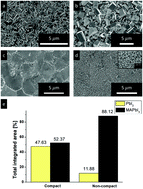Morphology control of perovskite films: a two-step, all solution process for conversion of lead selenide into methylammonium lead iodide
Abstract
We describe a two-step, all solution process for converting lead selenide thin films into methylammonium lead iodide (MAPbI3) perovskite material. PbSe was deposited on fluorine-doped tin oxide (FTO), and treated with polyiodide solution to form lead iodide. The solvent used was mixtures of isopropanol and water at different ratios. Conversion parameters, namely solvent ratio, potassium iodide (KI) concentration, iodine (I2) concentration and conversion temperature were optimized. A second conversion step, from PbI2 to MAPbI3, was carried out by treating the films with a solution of methylammonium iodide (MAI) dissolved in isopropanol. Different morphologies of MAPbI3 were achieved by converting PbI2 films with different morphologies, and also by converting PbI2 films using solutions of variable MAI concentration. Effect of grain size on UV-Vis light absorption and photoluminescence (PL) is discussed: while absorption was found to be lower for the films with smaller grain size, PL was higher, suggesting less non-radiative recombination traps in films containing smaller grain perovskites.



 Please wait while we load your content...
Please wait while we load your content...